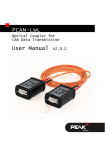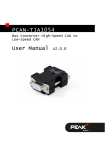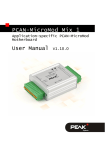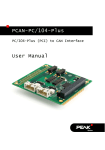Download PCAN-LWL - User Manual
Transcript
PCAN-LWL Optical Coupler for CAN-Data Transmission User Manual V2.0.0 PCAN-LWL – User Manual Products taken into account Product Name Model Part number PCAN-LWL IPEH-002026 CANopen® and CiA® are registered community trade marks of CAN in Automation e.V. All other product names mentioned in this document may be the trademarks or registered trademarks of their respective companies. They are not explicitly marked by “™” or “®”. © 2011 PEAK-System Technik GmbH PEAK-System Technik GmbH Otto-Roehm-Strasse 69 64293 Darmstadt Germany Phone: +49 (0)6151 8173-20 Fax: +49 (0)6151 8173-29 www.peak-system.com [email protected] Document version 2.0.0 (2011-11-18) 2 PCAN-LWL – User Manual Contents 1 Introduction 1.1 Properties at a Glance 1.2 System Requirements 1.3 Scope of Supply 4 4 5 5 2 Connections 2.1 CAN 2.2 OWG 2.3 Power supply 6 6 7 8 3 Configuration 3.1 Selecting High-speed or Low-speed CAN transceiver 3.2 Selecting the Power Supply Input 3.3 CAN Termination 3.3.1 Termination at High-speed CAN Bus 3.3.2 Termination at Low-speed CAN Bus 9 10 11 12 12 12 4 Operation 4.1 CAN Bit Rate 4.2 Signal Delay 4.3 Status LED 4.3.1 Red LED Low-speed „Error“ 14 14 14 16 16 5 17 Technical Specification Appendix A CE-Certificate 18 Appendix B Dimension Drawing 19 Appendix C Quick Reference 20 3 PCAN-LWL – User Manual 1 Introduction Tip: At the end of this manual (Appendix C) you can find a Quick Reference with brief information about the installation and operation of the PCAN-LWL. For use in explosion-proof areas or for EMC measurements, the PCAN-LWL can be used to replace a stretch of CAN network with a fibre-optic line at any point. There are the options of conversion to High-speed CAN or Low-speed CAN. The modules are supplied with power externally. 1.1 Properties at a Glance LED display for transceiver status High-speed CAN: AMIS 30660 transceiver, max. 500 kbit/s, switchable 120 Ohm bus termination Low-speed CAN: TJA1054 transceiver, max. 125 kbit/s, switchable 510 Ohm / 5.6 kOhm bus termination, bus error display Fibre-optic duplex line, 62.5/125 μm, ST connectors Aluminum casing CAN bus connection via D-Sub, 9-pin (in accordance with CiA® 102) Supply voltage range from 6.5 to 30 V Supply via D-Sub 9 pin, or DC connector Operating temperature range from 0 to 70 °C (32 to 158 °F) 4 PCAN-LWL – User Manual Note: You can find additional information about the properties and the behavior of the LS-CAN transceiver TJA1054 in the corresponding data sheet, which you can download, e.g. from the NXP website: www.nxp.com 1.2 System Requirements High-speed CAN bus (ISO 11898-2, max. 500 kbit/s) or Lowspeed CAN bus (ISO 11898-3, max. 125 kbit/s) 9-pin D-Sub socket for connection to the PCAN-LWL modules (pin assignment according to specification CiA® 102) Power supply with AC adaptor or via CAN bus 1.3 Scope of Supply 2 CAN to optical waveguide converters including power supply units A choice of 5 or 10 m FO cable, 62.5 / 125 μm, duplex line, ST connector, other lengths available on request Manual in PDF format 5 PCAN-LWL – User Manual 2 2.1 Connections CAN Figure 1: Side of the case with toggle switch and CAN connector A CAN bus (High-speed CAN as well as Low-speed CAN) is used to the 9-pin D-Sub connector on the left side of the case. The pin assignment for CAN corresponds to the specification CiA® 102. Figure 2: Pin assignment CAN connector Pin 9 can be used to power the PCAN-LWL. In section 3.2 Selecting the Power Supply on page 11, you can find detailed information about the supply of the PCAN-LWL. 6 PCAN-LWL – User Manual 2.2 OWG Figure 3: Side of the case with OWG connectors, voltage socket and LEDs A PCAN-LWL module has two standardized ST connectors for the OWG connectors. The connectors are each responsible for transmission and reception of light signals. Both OWGs of the duplex line are marked with colors at each connector (red/black), where a color is assigned to one OWG each. Connect each OWG output of one module with the OWG input of the other. Optical wave guide (marker) Connect at 1. PCAN-LWL module Red LWL IN LWL OUT Black LWL OUT LWL IN 7 Connect at 2. PCAN-LWL module PCAN-LWL – User Manual 2.3 Power supply A PCAN-LWL module needs a DC voltage of 6.5 to 30 V. On the voltage input socket you can connect the supplied AC adapter. Figure 4: Assignment voltage input socket In section 3.2 Selecting the Power Supply on page 11, you can find detailed information about the supply of the PCAN-LWL. 8 PCAN-LWL – User Manual 3 Configuration At the PCAN-LWL housing the termination for a Low-speed CAN bus can be adjusted by a toggle switch and the termination for a High-speed CAN bus can be adjusted by a rotary switch. On the circuit board of a PCAN-LWL you can do the following settings affecting the basic operation: Choice between High-speed and Low-speed CAN transceiver Choice of the input for the power supply Tip: At shipment PCAN-LWL is pre-configured for use in a Highspeed CAN bus and for the power supply via the separate voltage input socket. If you use this common configuration, a change of the basic settings as described in this chapter is not needed. For the jumper settings on the circuit board this must be removed from the case. To do this, proceed as follows: 1. Remove the two screws from the left side of the case (side with the D-Sub connector). 2. Pull the circuit board with the lid out of the case. After changing the settings (see the following subsections) the assembly is done in the reversed order. 9 PCAN-LWL – User Manual 3.1 Selecting High-speed or Low-speed CAN transceiver The PCAN-LWL system can be integrated in a High-speed CAN bus as well as in a Low-speed CAN bus. The corresponding CAN transceiver or mode must be selected by a jumper block on the respective circuit board of the PCAN-LWL. Figure 5: Position jumper block JPB1 Jumper block JPB1 Choice of transceiver Meaning B-A High-speed CAN Default setting at delivery C-B Low-speed CAN When setting the jumper block, make sure that the turn switch always is located on the side of the labels for the pin rows „C B A“. While PCAN-LWL is operating, the set CAN mode is indicated by the corresponding LED at the case. Note: It is also possible to use different transceivers with the two connected PCAN-LWL modules (conversion High-speed CAN/Low-speed CAN). You should make sure (like in any other case) that the transfer rates are the same in both CAN busses. 10 PCAN-LWL – User Manual 3.2 Selecting the Power Supply Input A PCAN-LWL module can be powered by an external voltage source (e.g. with the supplied AC adapter) via the corresponding input socket or via pin 9 of the CAN connector (in each case 6.5 – 30 V DC). The power supply input to be used must be set with the jumper JP12 on the circuit board of the PCAN-LWL module. Figure 6: Position jumper JP12 Jumper JP12 Power supply via… Meaning 1-2 CAN connector, pin 9 At increased EMC requirements use a shielded cable for the supply and for CAN. 2-3 Input socket for power supply Default setting at delivery. Prefer this Input for EMC applications (additional integrated filter). The unused power supply input according to the setting is electrically isolated from the actual used power supply. Attention! Switch the power supply at the CAN bus off before connecting or removing the CAN plug at the PCAN-LWL module. Otherwise electronic parts may be destroyed, even on other nodes attached to the CAN bus. 11 PCAN-LWL – User Manual 3.3 CAN Termination A High-speed CAN bus (ISO 11898-2) must be terminated on both ends with 120 Ohms. Otherwise, there are interfering signal reflections and the transceivers of the connected CAN nodes (CAN interface, control device) will not work. 3.3.1 Termination at High-speed CAN Bus The High-speed CAN bus is terminated inside the PCAN-LWL module between CAN_L and CAN_H with 120 Ω. This termination can be switched on or off by using the turn switch that is accessible via the hole on the top side of the case. To do so, use a small flat tip screwdriver. The positions of the switch are defined as follows: ON: or OFF: 3.3.2 Termination at Low-speed CAN Bus Every node in a Low-speed CAN bus (ISO 11898-3) has a termination resistor. For optimum system conditions the whole CAN bus should be terminated with 100 Ω (parallel connection of all termination resistors). A single node should be terminated with 500 Ω up to 6 kΩ. To simplify the adaptation of the PCAN-LWL to existing CAN busses you can switch between the termination resistors 510 Ω (Position of toggle switch up) and 5.6 kΩ (Position of toggle switch down). 12 PCAN-LWL – User Manual Figure 7: Toggle switch on the side of the case with D-Sub connector For smaller CAN busses or for testing a single component the toggle switch should be set to 510 Ω. For monitoring or configuration of existing CAN busses, that are already optimized regarding termination, the toggle switch should be set to 5.6 kΩ to minimize an influence on the total termination. Note: When the High-speed CAN transceiver is activated, the toggle switch for the Low-speed CAN termination resistor doesn't have any influence. 13 PCAN-LWL – User Manual 4 4.1 Operation CAN Bit Rate When operating the PCAN-LWL modules it must be ensured that the bit rate is identical on the connected CAN busses. No conversion or automatic adaptation of the bite rate is done in the PCAN-LWL modules. 4.2 Signal Delay Through the implementation of electric signals to light signals in the two PCAN-LWL modules, a signal delay of approx. 250 ns for the OWG set (2x PCAN-LWL + 5 m OWG) arises in High-speed CAN operation. This corresponds to a cable length of 50 m. In Low-speed CAN operation the two PCAN-LWL modules have a signal delay of approx. 1.5 μs. This corresponds to a cable length of 300 m. Therefore, you should consider the dependence of the maximum length of a CAN bus on the bit rate. The following tables show the maximum possible CAN bus length at different bit rates. Since the travel time of light signals in OWGs approximately equals the travel time of electric signals in copper (about 5 ns/m), the length of the duplex OWG is be taken into account 1:1 for the length of the CAN bus. 14 PCAN-LWL – User Manual Bit rate High-speed CAN Max. Bus length without PCAN-LWL Max. Bus length with OWG set (2x PCAN-LWL + 5 m OWG) 500 kbit/s 110 m 60 m 250 kbit/s 240 m 190 m 125 kbit/s 500 m 450 m 50 kbit/s 1,3 km 20 kbit/s 3,3 km 10 kbit/s 6,6 km 5 kbit/s 13,0 km Bit rate Low-speed CAN Max. Bus length without PCAN-LWL For small bit rates the delay of the PCAN-LWL module can be neglected. Max. Bus length with OWG set (2x PCAN-LWL + 5 m OWG) 125 kbit/s 500 m 200 m 50 kbit/s 1,3 km 1 km 20 kbit/s 3,3 km 3 km 10 kbit/s 6,6 km 5 kbit/s 13,0 km For small bit rates the delay of the PCAN-LWL module can be neglected. The listed values have been calculated on the basis of an idealized system and can differ from reality. 15 PCAN-LWL – User Manual 4.3 Status LED LED Meaning Yellow on High-speed CAN connection Orange on Low-speed CAN connection Red on Error, Error condition on the Low-speed CAN 4.3.1 Red LED Low-speed „Error“ The red LED indicates the state of the error output of the Low-speed CAN transceiver. This output is active at following errors: Interrupt on CAN_H Interrupt on CAN_L Short circuit between CAN_H and GND Short circuit between CAN_H and VCC Short circuit between CAN_L and GND Short circuit between CAN_L and VCC Short circuit between CAN_H and CAN_L Please see the data sheet for the CAN transceiver TJA1054 for more details. Note: The red LED does not have any function at operation of PCAN-LWL in High-speed CAN mode. 16 PCAN-LWL – User Manual 5 Technical Specification CAN High-speed CAN D-Sub plug, 9 pins, in accordance with CiA® 102 Transceiver: AMIS 30660 Bit rate: max. 500 kbit/s Bus termination: switchable 120 Ω Low-speed CAN D-Sub plug, 9 pins; in accordance with CiA® 102 Transceiver: TJA1054 Bit rate: max. 125 kbit/s Bus termination: switchable 510 Ω / 5,6 kΩ Signal delay through 2x PCAN-LWL + 5 m OWG High-speed CAN: approx. 250 ns Low-speed CAN: approx. 1,5 μs Optical wave guide Optical fibre duplex line with ST connector Power supply Supply voltage 6,5 - 30 V Power consumption max. 50 mA (at 9 V) Enviroment Operating temperature 0 - 70 °C (32 - 158 °F) Temperature for storage and transport -40 - 100 °C (-40 – 212 °F) Relative humidity 15 - 90 %, not condensing EMC EN 55024:2003-10 EN 55022:2008-05 EC directive 2004/108/EG Ingress protection (DIN EN 60529) IP20 Measures Size 60 x 35 x 80 mm (B x H x T) See also dimension drawings Appendix B on page 19 Weight 138 g 17 PCAN-LWL – User Manual Appendix A CE-Certificate 18 PCAN-LWL – User Manual Appendix B Dimension Drawing This figure doesn’t show the actual size of the product. 19 PCAN-LWL – User Manual Appendix C Quick Reference Basic Settings on PCAN-LWL Circuit Board Jumper block JPB1 Choice of transceiver Meaning B-A High-speed CAN Default setting at delivery C-B Low-speed CAN Termination CAN mode Terminating resistor High-speed CAN 120 Ω between CAN_L and CAN_H ON: Low-speed CAN or , OFF: 510 Ω / 5,6 kΩ, switchable (toggle switch at the case) Status LED LED Meaning Yellow on High-speed CAN connection Orange on Low-speed CAN connection Red on Error, Error condition on the Low-speed CAN Connectors Voltage input socket: CAN: Vin = 6,5 – 30 V OWG: 20


































